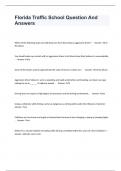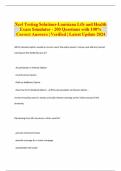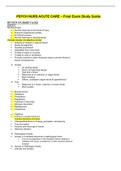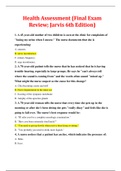Nurs 5315 UTA exam 1
1. Atrophy: E. Cells decrease in size
P. Still functional
Physiologic: thymus gland in early childhood
Pathological: disuse
2. Hypertrophy: E. Increase in cell size
P. Increased workload
Physiologic: weightlifting
Pathologic: cardiomegaly from HTN
3. Hyperplasia: E. Increase in cell number
P. Increased cellular division
Physiologic: liver regeneration
Pathologic: endometrial- usually r/t hormones
4. Dysplasia: E. Cells change in size, shape, organization
P. AKA atypical hyperplasia, a disorderly proliferation
Physiologic: N/A
Pathologic: squamous dysplasia of cervix from HPV
5. Metaplasia: E. one cell type replaced with another
P. reprogramming of stem cells, reversible
Physiologic: N/A
Pathologic: stratified squamous cells in bronchial lining r/t cigarette smoke
6. Hypoxia injury: E. inadequate oxygenation of tissues
P. decrease in mitochondrial function, decreased production of ATP increases
anaerobic metabolism. eventual cell death.
C.M. hypoxia, cyanosis, cognitive impairment, lethargy
7. Free radical and ROS: E. normal byproduct of ATP production, will overwhelm
the mitochondria- exhaust intracellular antioxidants P. lipid peroxidation,
damage proteins, fragment DNA
C.M. development in Alzheimer's, heart disease, Parkinson's disease,
Amyotrophic Lateral Sclerosis
8. Ethanol: E. mood altering drug, long term effects on liver and nutritional status
P. metabolized by liver, generates free radicals
1/6
, .
C.M. CNS depression, nutrient deficiencies-Mag, Vit B6, thiamine, PO4,
inflammation and fatty infiltration of liver, hepatomegaly, leads to liver failure
irreversible
9. Oncosis: Na and H2O enter cell and cause swelling. Organ increases in
weight, becomes distended and pale. Associated with high fever,
hypocalcemia, certain infections
10. Fatty Infiltration: intracellular accumulation of lipids in the liver
liver fails to metabolize lipids. usually from ETOH or high fat diet. can lead to
cirrhosis
11 dystrophic calcification: accumulation of Ca in dead or dying tissues calcium
salt clump and harden- interfere with cellular structure and function r/t pulmonary
TB, atherosclerosis, injured heart valves, chronic pancreatitis
12. metastatic calcification: accumulation of Ca in normal tissue result of
hypercalcemia r/t hyperparathyroidism, hyperthyroidism, toxic levels of Vit
D. Can also r/t hyperphosphatemia in renal failure
13. urate accumulation: sodium urate crystals are deposited in tissues- group of
disorders collectively called gout- acute arthritis, chronic gouty arthritis,
tophus, nephritis
14. Coagulative Necrosis: kidneys, heart, adrenals- secondary to hypoxia
15. Liquefactive Necrosis: nerve cells- brain- accumulation of pus
16. Caseous Necrosis: lung disease- usually TB- tissue looks like clumped
cheese
17. Fat Necrosis: breast, pancreas, abdominal structures- creates soaps
18. Gangrenous Necrosis: Dry- dark shriveled skin
Wet- internal organs- can lead to death
Gas- from clostridium- antitoxins and hyperbaric therapy
19. Gout: E. disturbances in serum urate levels. uncommon for < 30 years old. P.
uric acid is deposited in the tissues of kidney, heart, earlobes, and joints.
C.M. inflammation, painful joints. result of diuretic use or diet high in cream
sauces, red wine, or red meat
20. Rhabdomyolysis: E. cell hypoxia caused by severe muscle trauma,
hyperthermia, crush injuries, or severe dehydration
P. hypoxia leads to cell death, cellular contents are released in bloodstream.
C.M. CK is 5x upper normal limit, muscle pain, weakness, dark, reddish-brown
urine, hypercalcemia, renal failure
2/6










